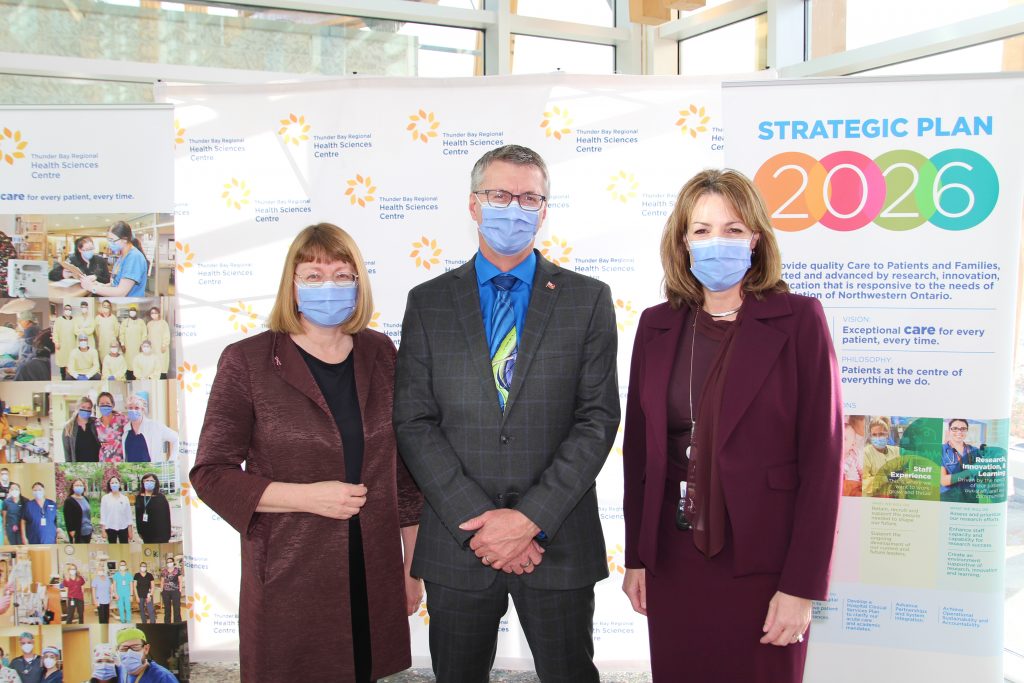Cancer Care in Northwestern Ontario Getting a Huge Boost
by Marcello Bernardo
 Pictured (From L-R): Dr. Margaret Anthes, Medical Lead, Radiation Oncology, Regional Cancer Care Northwest, TBRHSC; Kevin Holland, M.P.P. for Thunder Bay-Atikokan; and Dr. Rhonda Crocker Ellacott, President and CEO, TBRHSC and CEO, TBRHRI.
Pictured (From L-R): Dr. Margaret Anthes, Medical Lead, Radiation Oncology, Regional Cancer Care Northwest, TBRHSC; Kevin Holland, M.P.P. for Thunder Bay-Atikokan; and Dr. Rhonda Crocker Ellacott, President and CEO, TBRHSC and CEO, TBRHRI.People who live in Northwestern Ontario will soon have access to improved cancer care services closer to home thanks to funding from the Ontario government, Cancer Care Ontario and the Thunder Bay Regional Health Sciences Foundation.
The total project costs come in at just over $13.2M. It includes the addition of a new, third Linear Accelerator (LINAC) and a new state of the art Positron Emission Tomography (PET/CT) CT scanner. The PET/CT and LINAC are essential components of leading edge cancer diagnosis and treatment.
“We have seen firsthand the benefits to the patient of being able to offer quality cancer care closer to home,” said Dr. Rhonda Crocker Ellacott, President and CEO of Thunder Bay Regional Health Sciences Centre (TBRHSC) and CEO of Thunder Bay Regional Health Research Institute (TBRHRI). “Now thanks to this funding and donations, we will be able to address any gap in radiation therapy treatment capacity in the region, while keeping up with state of the art technology to accurately diagnose and manage best cancer care. This is great news for the communities we serve.”
PET/CT combines two general types of imaging – nuclear and x-ray. The PET (nuclear) imaging “lights up” cancer cells where they are present and the CT (x-ray) imaging allows doctors to see exactly where in the body those lit-up areas are located. PET/CT imaging allows doctors to more accurately diagnose and manage disease and supports physicians in developing a treatment plan. The current PET/CT is an aging unit due for replacement. The LINAC is used for radiation treatments for patients with cancer. It delivers high-energy electrons to the affected area, destroying the cancer cells while sparing the surrounding normal tissue. The technology is essential in supporting cancer care.
“We are pleased to announce the addition of a third linear accelerator to our Hospital,” said Dr. Nicole Laferriere, Chief of Oncology and Medical Director at Regional Cancer Care Northwest, TBRHSC. “Radiation therapy treatment volumes have grown to require this additional piece of equipment. We have seen firsthand the benefits to the patient of being able to offer cancer care closer to home. Now we will be able to address any gap in radiation therapy treatment capacity in the region.”
“This announcement is a game changer for cancer patients in the Northwest,” said Greg Rickford, Minister of Northern Development and M.P.P. for Kenora—Rainy River. “Our government is focused on improving health outcomes for people across the North, and this investment will allow northerners to get the best quality of care closer to home with loved ones by their side.”
“This is just one example of how our government is investing in our public healthcare system,” said Thunder Bay—Atikokan M.P.P. Kevin Holland. “The funding and technology is essential to meet the growing need for radiation therapy in our region and will improve access to care for cancer patients in Northwestern Ontario.”
The people of Northwestern Ontario also played a critical role in today’s announcement through their support of the Thunder Bay Regional Health Sciences Foundation’s PET/CT campaign.
“Through the generosity of our donors, and with funds from the Thunder Bay 50/50, we will be contributing $500,000 to the PET/CT project,” said Katy Commisso, Chair of Governance of the Thunder Bay Regional Health Sciences Foundation Board of Directors. ”We are pleased to support this new replacement scanner, which will allow the Hospital to do more for patients with it than ever before.”
Beyond cancer care services, the new PET/CT scanner has advanced technology that can be used for other diseases including cardiac disease. PET/CT can give heart surgeons a 3D image of your heart – an important tool as our Cardiovascular Surgery program grows. It will make planning surgeries easier and ultimately lead to better results.
The new PET/CT scanner is anticipated to be operational and in use by August 2023, while the third new Linear Accelerator is expected to be in service for use by December 2023.